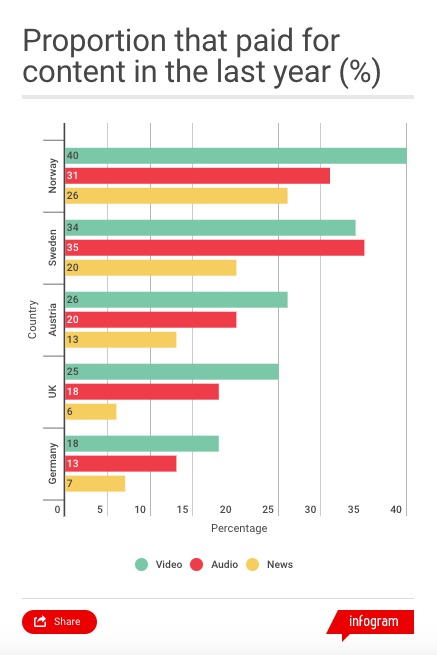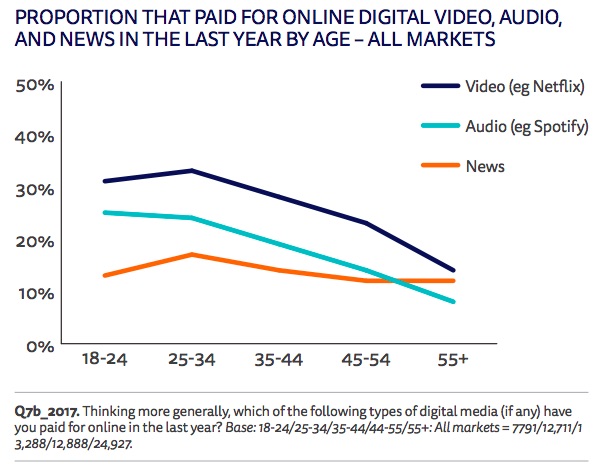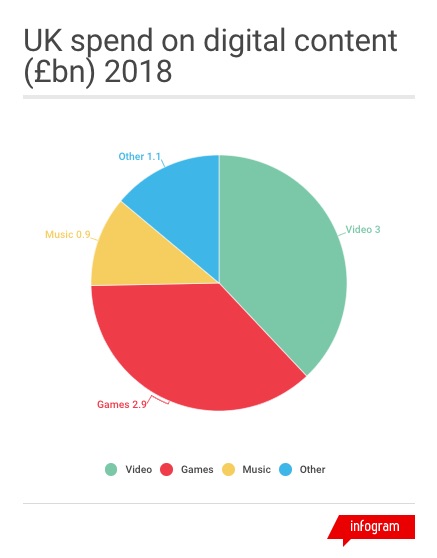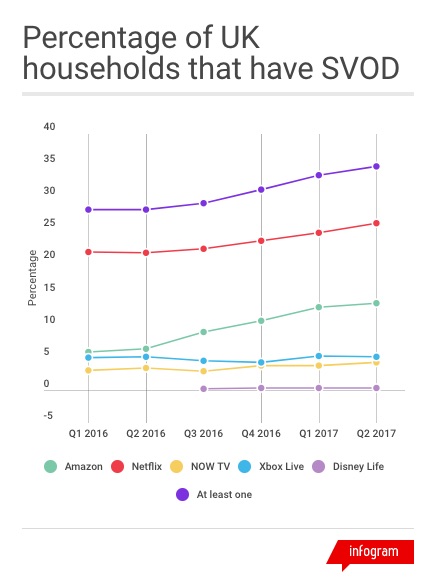
While advertising still funds the majority of online content, media companies, particularly news brands, are looking for more ways to grow direct customer revenue. Here are four charts on subscriptions in the U.K.
Not many people pay for news in the UK, but growth is forecast
In the U.K., 6 percent of people pay for news, according to the Reuters Digital News Initiative. Growth has been slow, partly because not many mainstream news organizations are charging for their content yet, according to Nic Newman, researcher at Reuters Institute for the Study of Journalism. Since newsrooms have come to terms with the fact that digital advertising alone will not sustain them, almost all news publishers are looking for some kind of alternative reader revenue.
The same study found that 9 percent are likely to pay for news at some point in the future. But Newman estimates that in the next five to 10 years, the number of people willing to pay for news could grow from 6 percent to 20 percent as free options fade and people become more familiar with paid models in entertainment, like Netflix and Spotify.
For news brands, growth could be hampered as more international titles like The New York Times and The Washington Post look overseas for growth and offer competitive pricing. “The fact that people are only prepared to pay for one news subscription will limit growth,” said Newman. “As more newspapers put up individual paywalls, that will run up against the desire for a plurality of sources, which is what people have had and liked about the internet.”

Ad position: web_incontent_pos1
More people pay for entertainment rather than news
Newman said it’s historically been more common for people to pay for entertainment over news: People put a higher value on entertainment because it has a longer shelf life and the content is more unique. News subscriptions that go unread feel wasted.
Globally, the number of people who pay for entertainment is higher in younger age groups, according to the Reuters report. Young people will pay for content, but news brands haven’t done as good a job at convincing them to as entertainment brands.

Ad position: web_incontent_pos2
Subscription video is driving growth
Juniper Research estimates that global consumer spending on digital content will reach $202 billion (£154 billion) in 2018 — up 10 percent from $184 billion (£140 billion) this year — with the U.K. accounting for $10.4 billion (£7.9 billion). Online gaming and video are the biggest categories in the U.K.; gaming leads globally. Subscription video on demand is driving the growth, as content providers like Netflix, Amazon and Facebook beef up the content available on their platforms, according to the report.

Multiple subscriptions are common for entertainment
Unlike digital news subscriptions, people are more likely to have more than one subscription for entertainment. Thirty-five percent of U.K. households subscribe to one or more SVOD service (compared to 76 percent in the U.S.), according to data from the Broadcasters’ Audience Research Board via Enders Analysis. The trend of multiple subscriptions is growing as more skinny-bundle services emerge in the U.K.

Platforms are starting to compete for sports rights, the crown jewel of which are the Premier League football rights, up for renewal in 2018 and priced at over $1.77 billion (£1.35 billion) for three seasons, according to a white paper from Juniper Research.
Amazon seems well-positioned for a successful bid. At the end of June, Amazon’s penetration of U.K. households was 14 percent, according to BARB data. Based on the amount of subscription revenue plus sponsorship revenue it could earn from streaming the matches, Amazon would need to double its U.K. penetration to justify spending on the Premier League rights.
More in Media

NewFronts Briefing: Samsung, Condé Nast, Roku focus presentations on new ad formats and category-specific inventory
Day two of IAB’s NewFronts featured presentations from Samsung, Condé Nast and Roku, highlighting new partnerships, ad formats and inventory, as well as new AI capabilities.

The Athletic to raise ad prices as it paces to hit 3 million newsletter subscribers
The New York Times’ sports site The Athletic is about to hit 3 million total newsletter subscribers. It plans to raise ad prices as as a result of this nearly 20% year over year increase.

NewFronts Briefing: Google, Vizio and news publishers pitch marketers with new ad offerings and range of content categories
Day one of the 2024 IAB NewFronts featured presentations from Google and Vizio, as well as a spotlight on news publishers.
Ad position: web_bfu



